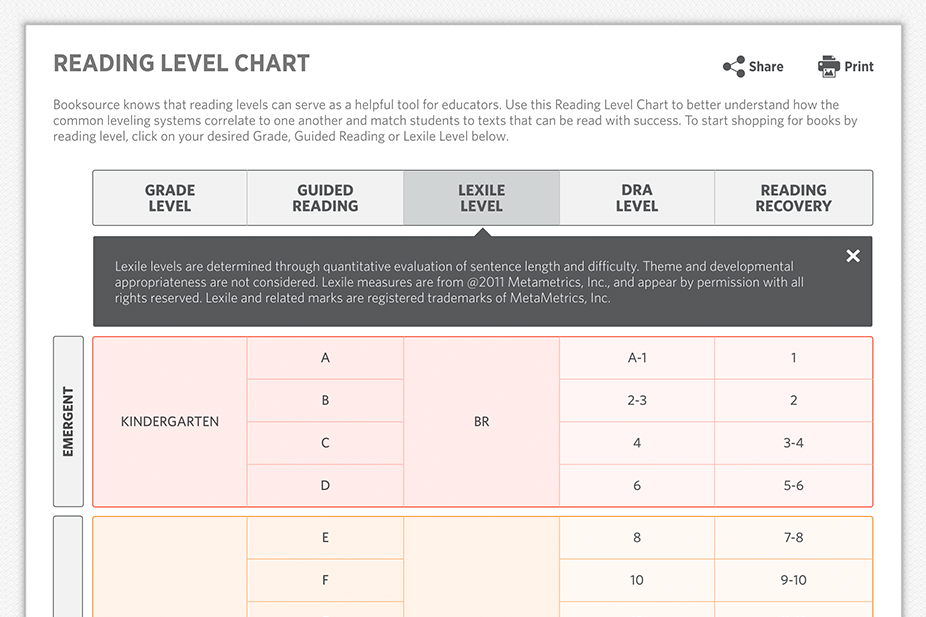At Booksource, we know that reading levels can serve as a helpful tool for educators. Reading levels—including Guided Reading Level, Lexile Level, DRA Level and Reading Recovery Level—can make it easy to identify characteristics of reading proficiency at each grade level and match students to texts that can be read with success.
A Quick and Easy Way to Compare Different Reading Level Systems
With several different leveling systems, it can sometimes be challenging for teachers to quickly determine how the levels compare, especially when trying to choose the best books for students. Whether you’re actively working to move students up the ladder of text complexity or just want to stock your classroom library with books at the right reading levels for the grade(s) you teach, our newly updated Reading Level Chart can help.
Here’s why we think you’ll love it:
1. It has a new and improved name! Formerly known as the Booksource Leveled Text Chart, we’ve updated the name to Booksource Reading Level Chart to more accurately reflect the terms that educators are searching for. (FYI, Reading Level Correlation Chart and Reading Level Comparison Chart are popular search terms too.)
2. You’ll find the same helpful reading level information as before. We didn’t take anything away—promise! We’ve just added some neat new features to make your life easier.
3. You can see the correlation between leveling systems at a glance. Which Guided Reading levels correlate to a Grade 1 interest level? How do they compare to Lexile levels? This chart is a nice visual representation of how the various leveling systems compare.
4. The new Reading Level Chart includes reading stages. You can now use our Reading Level Chart to see how the stages of reading development (emergent, early, etc.) roughly correlate to the different reading level systems. Descriptions of reading skills and habits at each of these stages are also now included.
5. You can use the new Reading Level Chart to shop for books by level. When you view the new Reading Level Chart online, you’ll notice that it’s now interactive. If you click on Level A in the Guided Reading column, for example, you’ll be taken to browse Level A Collections on Booksource.com. What an easy way to locate exactly the books you need!
6. The Reading Level Chart can also help you identify high interest/low reading level titles. Being able to quickly compare Lexile and Guided Reading levels can help you identify the right books for younger students reading at a high level and older students who need a lower Lexile but higher maturity level.
7. You can print it (in two different sizes). Sometimes, you just need a paper copy, right? We’ve made it easy to print the Reading Level Chart as either a full page document or in a smaller, teacher-friendly 3×5 size.
8. You can easily share it with your friends. With a handy share button right at the top, it’s easy to share the Booksource Reading Level Chart with your friends and co-workers. Tweet it, pin it, post it to your favorite Facebook group—wherever your friends hang out!
9. It can serve as a helpful framework for broader literacy instruction. Reading levels can play a valuable role in literacy instruction, but they are just one piece of a much larger puzzle. Like reading levels themselves, this Reading Level Chart is one of many tools you can use to get the right books in the hands of students and foster a lifelong love of reading.
(For more on reading levels, check out A Level Is a Teacher’s Tool, Not a Child’s Label on the Fountas and Pinnell blog).
10. If you have questions, we have answers. With several literacy experts on staff, we’d love to answer any questions you may have about this chart, the correlation between the various leveling systems or how to select books at the right reading levels in general. Seriously. Just give us a call at 800.444.0435 and we’re happy to help.
Check out the new Reading Level Chart and let us know what you think. We’d love to hear your feedback so we can make this tool as useful as possible for educators like you!





Leave A Comment